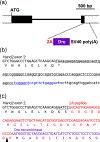A knock-in allele of Hand2 expressing Dre recombinase
- PMID: 38703044
- PMCID: PMC11088872
- DOI: 10.1002/dvg.23601
A knock-in allele of Hand2 expressing Dre recombinase
Abstract
HAND2 is a basic helix-loop-helix transcription factor with diverse functions during development. To facilitate the investigation of genetic and functional diversity among Hand2-expressing cells in the mouse, we have generated Hand2Dre, a knock-in allele expressing Dre recombinase. To avoid disrupting Hand2 function, the Dre cDNA is inserted at the 3' end of the Hand2 coding sequence following a viral 2A peptide. Hand2Dre homozygotes can therefore be used in complex crosses to increase the proportion of useful genotypes among offspring. Dre expression in mid-gestation Hand2Dre embryos is indistinguishable from wild-type Hand2 expression, and HandDre efficiently recombines rox target sites in vivo. In combination with existing Cre and Flp mouse lines, Hand2Dre will therefore extend the ability to perform genetic intersectional labeling, fate mapping, and functional manipulation of subpopulations of cells characterized by developmental expression of Hand2.
Keywords: Dre/rox; heart; limb bud; mouse; neural crest; sympathetic neurons.
Published 2024. This article is a U.S. Government work and is in the public domain in the USA. genesis published by Wiley Periodicals LLC.
Conflict of interest statement
Figures



Similar articles
-
A knock-in allele of En1 expressing dre recombinase.Genesis. 2016 Aug;54(8):447-54. doi: 10.1002/dvg.22954. Epub 2016 Jul 9. Genesis. 2016. PMID: 27313055 Free PMC article.
-
Dre - Cre sequential recombination provides new tools for retinal ganglion cell labeling and manipulation in mice.PLoS One. 2014 Mar 7;9(3):e91435. doi: 10.1371/journal.pone.0091435. eCollection 2014. PLoS One. 2014. PMID: 24608965 Free PMC article.
-
Conditional deletion of Hand2 reveals critical functions in neurogenesis and cell type-specific gene expression for development of neural crest-derived noradrenergic sympathetic ganglion neurons.Dev Biol. 2008 Jul 15;319(2):179-91. doi: 10.1016/j.ydbio.2008.03.036. Epub 2008 Apr 8. Dev Biol. 2008. PMID: 18501887 Free PMC article.
-
The Hand2 gene dosage effect in developmental defects and human congenital disorders.Curr Top Dev Biol. 2014;110:129-52. doi: 10.1016/B978-0-12-405943-6.00003-8. Curr Top Dev Biol. 2014. PMID: 25248475 Review.
-
Gene replacement strategies to test the functional redundancy of basic helix-loop-helix transcription factor.Pediatr Cardiol. 2010 Apr;31(3):438-48. doi: 10.1007/s00246-010-9669-x. Epub 2010 Feb 14. Pediatr Cardiol. 2010. PMID: 20155416 Free PMC article. Review.
References
Publication types
MeSH terms
Substances
Grants and funding
LinkOut - more resources
Full Text Sources
Molecular Biology Databases

